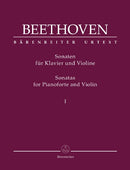| 作曲者 | Ludwig van Beethoven (1770-1827)・ルートヴィヒ・ヴァン・ベートーヴェン |
| タイトル | Sonaten für Klavier und Violine = Sonatas for Pianoforte and Violin Vol. 1 |
| 出版社 | Bärenreiter・ベーレンライター |
| 楽器編成 | Violin and piano |
| 品番 | 979-0-006-53296-4 |
| 校訂者 | Clive Brown |
| 言語 | 英語 • ドイツ語 |
| 形状 | 1360 g・ソフトカバー |
| 出版番号 | BA 9014 |
| ISMN | 979-0-006-53296-4 |
| その他 | With an Urtext violin part and a second violin part with historically accurate fingering and bowing |
Beethoven’s ten sonatas for piano and violin, along with those by Mozart, constitute the heart of this classical music genre. Following the lead of Mozart’s late sonatas, Beethoven lets the violin part become increasingly independent from the piano part. Not only does Clive Brown’s scholarly critical edition offer a meticulously edited text but for the first time it presents a list of sources and a Critical Report. Furthermore Brown documents a great number of passages where, by today’s standards, the notation raises some questions. These passages had previously been overlooked in the autograph but their significance is now clarified. One example can be found in Beethoven’s “Tempo di Minuetto” from Sonata op. 30 No. 3, where he uses a notational idiosyncracy based on C.P.E. Bach’s “Versuch über die wahre Art das Clavier zu spielen” to denote a rest. This musical symbol, which was included in the first edition published during Beethoven’s lifetime, has not been addressed in any modern edition to date. In addition, a score through a chord can also not be found in previous modern editions; this denotes an arpeggiated chord.
Einleitung · Beethovens Notation - zwischen den Zeilen gelesen · Sonate in D op. 12, Nr. 1 · Sonate in A op. 12, Nr. 2 · Sonate in Es op. 12, Nr. 3 · Sonate in a op. 23 · Sonate in F op. 24 · Early Perfoming Editions and Historical Metronome Marks · Critical Report



